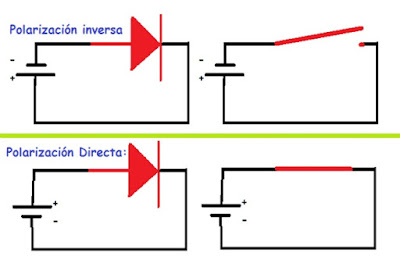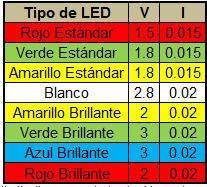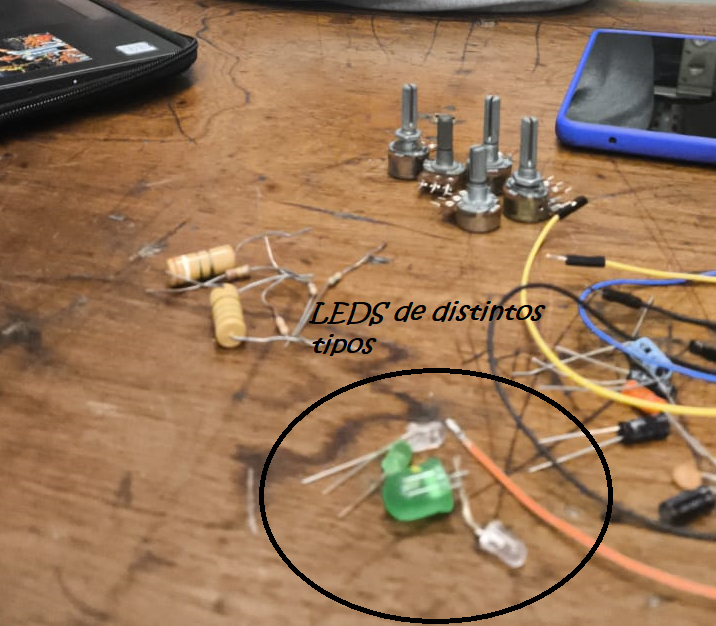¿Como calcular la resistencia de un led ? // How to calculate the resistance of an LED?
¡Hola compañeros de Hive!
En este post, quiero compartir con ustedes cómo calcular la resistencia adecuada para conectar en serie con un LED, de manera que este brille con la intensidad correcta sin riesgo de quemarse.
Cálculo de la Resistencia para un LED
¿Por Qué Necesitamos una Resistencia?
Los LEDs son componentes sensibles y necesitan una corriente constante para funcionar correctamente. Sin una resistencia que limite esta corriente, el LED podría recibir demasiada energía y dañarse.

entre un ejemplo y el otro se invirtió la polaridad de la fuente de alimentación, sin resistencia el led se puede quemar o funcionar mal

¿Porque no se puede conectar directamente a la fuente?
La tensión umbral es el valor de tensión en polarización directa a partir del cual un diodo conduce. Si yo le pongo mas de esa tensión , este se quemara por eso no se puede conectar directo a fuentes o baterías ( a menos que consiga una fuente o batería con el valor de tensión exacto) y también tienen una corriente ideal en la cual brillaran al nivel optimo pensado por el fabricante , dependiendo de la cantidad de corriente que lo atraviesen vamos a ver como el led brillara mas o menos en función de esta.
(generalmente tiene una corriente,mínima,máxima y típica)
(generalmente tiene una tensión,mínima,máxima y típica)

Acá les dejo un cuadro comparativo entre los distintos colores, tensiones y corrientes típicas
La formula para calcular la Resistencia
Para calcular la resistencia adecuada, utilizamos la Ley de Ohm, que se expresa de la siguiente manera:
R = ( Vfuente - Vled) / Iled
R es la resistencia en ohmios (Ω).
Vfuente es el voltaje de la fuente de alimentación.
Vled es el voltaje de operación del LED (generalmente entre 1.8V y 3.3V, dependiendo del color y tipo de LED).
Iled es la corriente recomendada para el LED (normalmente entre 10mA y 20mA).
Supongamos que tenemos:
Una fuente de alimentación de 9V.
Un LED con un voltaje de operación de 2V.
Una corriente de operación de 20mA (0.02A).
Según la formula para calcular la resistencia nos da una R de 350 ohms , con lo cual con esa resistencia nos aseguramos que por nuestro led circulan 20 mA y funciona en un nivel optimo.

Leds de distintos tipo en mi escritorio en Buenos Aires, Argentina jaja.
..............................................................................................
Hello fellow Hive!
In this post, I want to share with you how to calculate the appropriate resistance to connect in series with an LED, so that it shines with the correct intensity without the risk of burning out.
Calculation of Resistance for an LED
Why Do We Need a Resistance?
LEDs are sensitive components and require a constant current to function properly. Without a resistor limiting this current, the LED could receive too much power and be damaged.

between one example and the other the polarity of the power supply was reversed

Why can't it connect directly to the source?
The threshold voltage is the forward bias voltage value above which a diode conducts. If I put more than that voltage on it, it will burn out, which is why it cannot be connected directly to sources or batteries (unless I get a source or battery with the exact voltage value) and they also have an ideal current at which they will glow at the same time. optimal level designed by the manufacturer, depending on the amount of current that passes through it, we will see how the LED will shine more or less depending on this.
(generally has a minimum, maximum and typical current)
(generally has a minimum, maximum and typical voltage)

Here is a comparative table between the different colors, typical voltages and currents
The formula to calculate the Resistance
To calculate the appropriate resistance, we use Ohm's Law, which is expressed as follows:
R = (Vsource - Vled) / Iled
R is the resistance in ohms (Ω).
Vsource is the power supply voltage.
Vled is the operating voltage of the LED (generally between 1.8V and 3.3V, depending on the color and type of LED).
Iled is the recommended current for the LED (normally between 10mA and 20mA).
Suppose we have:
A 9V power supply.
An LED with an operating voltage of 2V.
An operating current of 20mA (0.02A).
According to the formula to calculate the resistance, it gives us an R of 350 ohms, so with that resistance we ensure that 20 mA circulates through our LED and works at an optimal level.

LEDs of different types on my desk in Buenos Aires, Argentina haha.
Congratulations @tecnotronics! You have completed the following achievement on the Hive blockchain And have been rewarded with New badge(s)
Your next target is to reach 100 comments.
Your next target is to reach 3000 upvotes.
You can view your badges on your board and compare yourself to others in the Ranking
If you no longer want to receive notifications, reply to this comment with the word
STOPCheck out our last posts:
Thanks for your contribution to the STEMsocial community. Feel free to join us on discord to get to know the rest of us!
Please consider delegating to the @stemsocial account (85% of the curation rewards are returned).
You may also include @stemsocial as a beneficiary of the rewards of this post to get a stronger support.